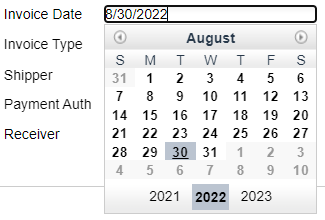Table of Contents
Invoice Overview - Legacy
Invoices expend funds encumbered by a line item or Blanket Order direct charge on a purchase order. You can also expend funds directly on an invoice using a Direct Charge.
Parts of an Invoice from the Top Down
Lineitems – The number of line items on the invoice
Receive Items button (Top Right) – Click to go to the receiving screen to receive items on the invoice.
Expected Cost – Total cost for the invoice.
Hide/Show Details button – Hides or shows the invoice header fields.
Invoice Header Fields
Orange highlighted fields are required.
Vendor Invoice ID (required) – The vendor’s invoice number on the invoice.
Invoice Date (required) – The date on the invoice. The form defaults to todays date. Clicking in the box will pop up a date widget from which you can choose the date on the invoice.
Receive Method – Choose the appropriate option from the dropdown. (Either EDI or Paper)
Invoice Type – Free text field.
Provider (required) – This is a typeahead box. Start typing the provider code and select it from the list when it appears.
Shipper (required) – This is the same as the Provider. It fills in automatically when the Provider is chosen.
Note – A free text field. EDI messages also display here. Additional notes can be added if EDI messages are present.
Payment Auth – Free text field.
Payment Method (required) – Choose the appropriate option from the dropdown.
Receiver (required) – Choose the appropriate org unit from the dropdown.
Invoice and Search Tabs
Invoice tab – Lists the line items and direct charges (if any) on the invoice.
Search tab – Takes you to the line item search interface where line items can be retrieved and added to the invoice.
Line Items Section
Bibliographic Information
Blue title link – Takes you to the purchase order. 
Author – The author of the title you are ordering
ISBN – The ISBN of the title you are ordering
Order Status Information
From Left to Right
Number of items Ordered
Number of items Received
Number of items Invoiced
Number of items Claimed
Number of items Cancelled
Number of items Delayed
Debit Information
Estimated – The Estimated Price entered for the line item on the purchase order.
Encumbered – The amount of money the line item is encumbering.
Paid – The amount of money that has been invoiced for the line item.
Line Item Information
Line item ID – The unique identifier for the line item. 
Blue purchase order link – Displays the PO name and the activation date. Takes you to the purchase order when clicked.
Number of Items Invoiced and Cost
# Invoiced / # Paid – Filled in automatically for EDI invoices. Both fields need to be filled in if invoicing manually. The number in both fields should be the same.
Billed – Filled in automatically for EDI invoices. Fill in the billed amount from the paper invoice for manual invoicing. Clicking Tab or clicking outside the billed box will automatically fill in the Paid amount.
Per Copy – The price for each copy automatically displays here.
Paid – Filled in automatically for EDI invoices. For manual invoicing, the Paid amount will be filled in from the Billed amount. The Billed and Paid amounts should always be the same.
Detach – Click this to remove a line item from the invoice.
Direct Charges, Taxes, Fees, etc.
Direct charges in an invoice can be used to expend funds without an associated line item. Direct charges can be used for shipping fees, handling fees, taxes, credit memos, etc. There is also a special direct charge for blanket orders where you can encumber an amount in a purchase order and expend that amount over a period of time through invoicing. Credit Memos are used to apply a vendor credit to a fund and are usually done on a separate invoice. See more about adding Direct Charges.
Charge Types That Can Be Used in an Invoice
- Tax
- Handling Charge – Use with the Prorate button.
- Non-Library Item
- Serial Subscription
- Credit Memo – Used to negate an invoiced amount. Credits are usually issued by the vendor and should be entered into Acquisitions if the invoice has been finalized.
- Salesman’s Order
- Standing Order
- Library Item
- Processing Fee – Use with the Prorate button.
- Shipping Charge – Use with the Prorate button.
- (Non-prorated) Shipping Charge
- (Non-prorated) Processing Fee
- (Non-prorated) Handling Charge
- Database
Fund – Select the appropriate fund from the dropdown. Charges that come in on an EDI invoice will need to have a fund selected manually.
Title/Description – (optional) A free text field used to describe what the charge is for. If the charge if for a particular title, database, etc., it is a good idea to enter that here.
Billed – Amount billed on the invoice
Paid – Should always be the same as the billed amount
Delete – Clicking on the Delete link will delete the charge from the invoice. The invoice must be open to delete a charge.
Buttons and Totals
Save – Saves the invoice. Saving the invoice does not disencumber or expend money. Use Save when you need to come back to the invoice at a later time to finish it.
Save & Clear – Saves the invoice and clears the form so you can enter a new invoice. 
Prorate – Applies the selected prorated charge to the funds. 
Close – Finalizes the invoice. Closing an invoice is the process that moves your money from being encumbered to being “spent”.
Total – Total amount billed
Total (grey background) – Total amount paid
Balance – The difference between the total billed and total paid amounts. 
Reopen – The Reopen button appears when an invoice has been closed. Clicking the Reopen button puts the invoice back into an editable mode so that you can make corrections, if necessary. 









